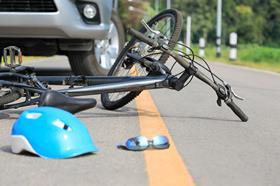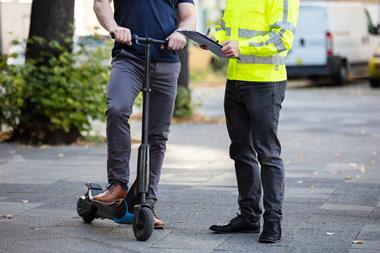Brokers will be at the forefront when it comes to educating the public about the changes, while insurers will need to watch out for fraud
Significant changes to the Highway Code reflect a “shift too far in the balance of vulnerable road users”, which could cause “absolute chaos” for commercial fleet drivers in London, according to Naomi North, partner and head of motor crime at law firm Kennedys.
The Highway Code was originally introduced in April 1931 as part of the Road Traffic Act 1930. It cost one penny to purchase and contained just 21 pages of driving guidance.
However, on 29 January 2022, the UK government’s Department for Transport (DfT) activated 50 new changes to the Highway Code - it now contains more than 300 rules spread over 150 pages.
The code’s revamp has been designed to help reduce carbon emissions, boost societal health and create a more respectful and considerate culture around safe road use.
As part of the changes, the DfT has introduced three key new rules:
- Rule H1: Hierarchy of road users – drivers of vehicles that can cause the greatest harm in a collision, such as heavy goods vehicle (HGV) drivers, bear the greatest responsibility to take care and reduce danger to others.
- Rule H2: New priority for pedestrians at junctions – drivers, motorists and cyclists should give way to pedestrians crossing or waiting to cross.
- Rule H3: Priority for cyclists when cars are turning – motorists should not cut across cyclists.
According to Jel Consulting founder and director Eddie Longworth, the revised code’s overriding factor to improve road safety - especially for vulnerable users - is a “welcome development”.
The “danger” of the new rules, however, is that the hierarchy created in Rule H1 will become a determining factor when establishing liability and damages following road accidents.
He explained: “Previously, breaching the Highway Code [was] not in itself an indication of liability, but the new arrangements could see a plethora of court cases to establish precedent and case law.
“In turn, we can expect initial confusion and inconsistency as motor insurers will vary in how they apply the new rules.”
Marc Wanless, head of motor for commercial lines at Aviva, added that it is “vitally important that commercial drivers are aware of the changes to the code and what this means when driving for work”.
This is because those “driving larger vehicles are higher up the hierarchy” and therefore ”pose a greater risk to vulnerable road users, such as cyclists, horse riders and pedestrians”.
However, North believes the “biggest concern” for commercial fleet drivers is Rule H2, especially in areas with high congestion, such as London, because it places “a heavy burden on HGV drivers, who have already got six mirrors to check, multiple cameras to look at [and] sensors to listen to”, she said.
“I have no doubt [that] short-term this could increase accidents, congestion [and] chaos on the roads,” she added. “It’s going to be a problem – both civilly and criminally.”
Fraud potential
An additional issue concerning Kennedys legal director Ben Appleton is that the new law listed in Rule H2 does not state that pedestrians must cross at the safest point possible. It therefore fosters the idea that pedestrians’ safety is “no longer their responsibility”.
He explained: “The obvious [issue] that comes to mind is a pedestrian crossing [a junction] at a point where the driver can actually see, or is the driver only able to see them at the last minute, slamming on brakes [and] causing traffic jams leading into junctions?”
Rule H3 could also prove to be a problem for HGV drivers because cyclists – whether travelling in cycle lanes, or down the side of a vehicle or HGV – will have right of way, “placing them in a real position of danger”, said North.

“[Rule H3] assumes that [drivers have] seen [cyclists] in the first place,” she continued - this cannot be assumed, however, especially considering how HGVs often display stickers warning about their blind spots.
“For me, this just goes against everything we’ve been trying to tell cyclists in the past,” North noted.
As a result, Appleton and Longworth expect to see an increase in fraudulent, staged accidents involving cyclists and pedestrians, which could look like a “pedestrian taking the role of a vehicle in a slam-on-shunt type situation”, said Appleton.
Longworth added: “Criminal gangs will be quick to exploit uncertainty and seek additional compensation for alleged breaches of the new rules.
“This could well be a dangerous development as cyclists, for example, could easily be injured even in staged accidents.
“Nevertheless, we can expect to see an increase in volume in this category of claims.”
When handling disputed liability cases in the past, North noted that drivers’ defence has often been that they were unable to anticipate that the pedestrian was going to step off the pavement without warning.
“A lot of those cases don’t even get run by the police because there is this acknowledgement that there’s only so many checks you can make and only so much you can do when driving,” she said. “My concern is [the new rules] now will take away that perfectly legitimate defence that we’ve been running for many years and that just cannot be right.”
If a commercial fleet driver does end up in court now that the Highway Code changes have come into fruition and a hierarchy issue is at play, Appleton warned of assumptions around presumed liability. With cases going forward, he recommended that insurers make early decisions on which party is legally responsible for road traffic accidents.
Brokers’ responsibility
To mitigate potential increases in claims costs, Longworth said that the broking community has a “responsibility to educate motorists and other road users in the detail of the new rules and how they will be applied”.
Wanless agreed that brokers are “well placed” to do this, as well as “help businesses adapt to the changes as they have an in-depth understanding of the risks each client faces”.
Longworth continued: “I would certainly like to see information being provided at the point of policy purchase.
“If claims do occur, it is essential that the roadside information gathered by both fault and non-fault claimants reflects the new rules.

“For example, is there evidence of safer driving where a cyclist or pedestrian is involved?
“This is not an easy area of change for future claims management, but we owe it to our policyholders to make them aware of their new responsibilities as they may otherwise be caught up in larger and more complex claims.”
North added: “There will be a certain demographic of people that will not know about these changes – they don’t have access to the internet, or they’ve got no desire to look at these changes.
“[The] reality is for these updates to be effective and to ensure the road is safer for everyone, everyone needs to know about it - whether you’re an insurer, broker or fleet manager.”
For insurers, North suggested they send out an informational letter to all policyholders about the Highway Code changes. Meanwhile, brokers and transport managers should look to arrange training sessions for drivers.
“I think it’s something that’s so worthwhile, particularly those in cities that are driving in heavily congested areas,” she said.
“We have to make sure they’re aware of the changes and that will hopefully reduce collisions, but it will also follow on that people will know their respected roles in the hierarchy as well.”
Appleton added: “In terms of the awareness piece, obviously for the insurer is training for the claims handlers making liability decisions going forward.
“We are questioning how important some of the rules are, but there are significant changes here and everyone has to be aware of that going forward.”
Hosted by comedian and actor Tom Allen, 34 Gold, 23 Silver and 22 Bronze awards were handed out across an amazing 34 categories recognising brilliance and innovation right across the breadth of UK general insurance.






















































No comments yet